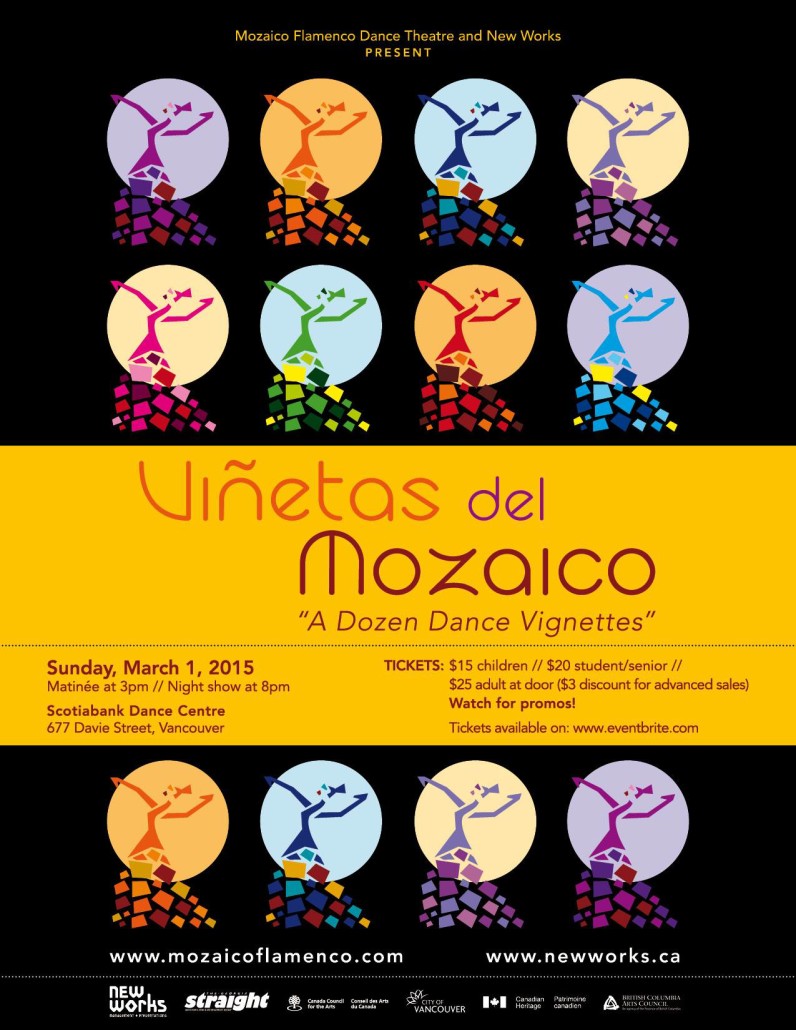Company: Shows
Café de Chinitas
Café de Chinitas is an enchanted cafe where red-golden cheong sams and Asian melodies fuse with flamenco’s virtuosity and bravado. This unique performance marks the first time the ‘East meets West’ fusion has ever been seen on a Vancouver stage.
“We adopted the name ‘Café de Chinitas’ because it blends fiery Flamenco dance with the exotic Asian sounds of the Orchid Ensemble. While Flamenco is typically fused with jazz and Latin music, it has never been expressed with a Chinese element, so this idea is truly original and also extremely relevant for the City of Vancouver, “ says Project Artistic Director Kasandra La China, “We aspire to create a local following for the Café de Chinitas series as a true representation of who we are. It is a pure reflection of our cultural identity.”
Café de Chinitas is crafted with a love of Flamenco and an appreciation for ethnic diversity. Living in Vancouver, a deep appreciation for multiculturalism comes naturally for Mozaico Flamenco whose dancers represent a diverse range of backgrounds including Spanish, Mexican, English, Chinese and Filipino. Café de Chinitas represents an opportunity to perform Flamenco at the highest calibre with great artistic integrity while also allowing us to express ourselves in a way that reflects our own cultural identity.
Our Secret Back Story to Café de Chinitas
You will be transported to the magical and mystical Café de Chinitas. The curtains open to reveal a hazy opium boudoir where women languish in a dreamlike state at tables offering drink and smoke. The music fades in and out with the wailing of the erhu and magical strumming of the zheng, producing a reverie of the old Café Cantante. This is a popular hang out for flamencos, aficionados, socialites, gypsies, toreros and women of the night. Café de Chinitas is a place where mischief, drama and intrigue happen!
The Music that Inspires Café de Chinitas
Flamenco with an Asian twist! The music of Café de Chinitas is a fusion of traditional Flamenco, which includes singer, guitarists, cajon and palmas, and the exotic sounds of the Orchid Ensemble. The Orchid Ensemble embraced working with us in 2006 and is committed to further developing flamenco repertoire. Our goal is to develop a musical genre based on the cultural exchange between Western and Asian musicians, and come up with a sound that is distinctly “Vancouver”.
Challenging Stereotypes in Flamenco
Mozaico Flamenco Dance Theatre juxtaposes Café de Chinitas with dance performance by a multicultural company, a Chinese-Flamenco fusion with Vancouver’s Orchid Ensemble and costumes that blend Asian fashion design. Mozaico Flamenco stands for Canada’s cultural mosaic. We challenge stereotypes that only gypsies or Spaniards can perform flamenco. Even today, the Spanish flamenco community still holds a prejudice against foreigners performing flamenco. It is assumed that if you are from a culture outside of Spain, you cannot interpret flamenco well. Mozaico Flamenco challenges that notion because we know that flamenco has grown beyond the boundaries of Spain and has been embraced by many cultures and people world wide. The reality is that Flamenco today is an international art form that has been embraced by many cultures and people outside of Spain…and we will prove that with our multicultural cast and guests.
The History of Café de Chinitas
The title “Café de Chinitas” means “Chinese Café”. In the mid 1800s, Café de Chinitas was a classic singing coffee shop in the city of Malaga in Southern Spain. It was a typical Café Cantante (flamenco tablao or nightclub) where people could see artists perform. These were the first clubs to feature flamenco outside of the intimate gypsy family gatherings. Historians call the Café Cantante the Golden Age of flamenco song, dance and music.
Federico Garcia Lorca described the inside of the café as an Andaluz patio made of pebbles, strewn with wooden tables and chairs. Built with Moorish arches and columns, the balconies were lined along the lateral walls and huge mirrors were hung around the establishment. Historians surmise that the name Café de Chinitas was given because there was extensive commerce with the orient (primarily the Philippines, part of the Spanish empire) during this era. Many Asian women, commonly known as “chinitas” used to regularly attend the cafe so the name became Café de Chinitas. Today Café de Chinitas is immortalized as a traditional Petenera song form with lyrics by Federico Garcia Lorca. There is also a famous flamenco tablao in Madrid with the same name.
The Song by Federico Garcia Lorca (1898 – 1936)
Café de Chinitas is a song written by poet, writer and musician Federico Garcia Lorca (1898 – 1936) which was influenced by the popular songs of his time. Café de Chinitas along with songs like Zorongo, Anda Jaleo and Los Cuatro Muleros were used by the Republicans during the Spanish Civil War as rallying songs for the their cause. Federico Garcia Lorca spins a tale of a rivalry between two brothers at the Café de Chinitas.
The Petenera Song Form
Café de Chinitas is a song form, palo, in flamenco called Petenera. It was danced in late 1800s by Maestro Jose Otero in Seville who used to choreograph to piano and perform it as a school dance, baile de escuelas. Later the Petenera was transformed into a song with three standard coplas (verses) accompanied by the guitar and eventually became adopted by flamenco into a dance with no form. Today there is a superstition surrounding Peteneras because someone died dancing it once and it is considered bad fortune to play it. Some gypsies still refuse to perform it!


